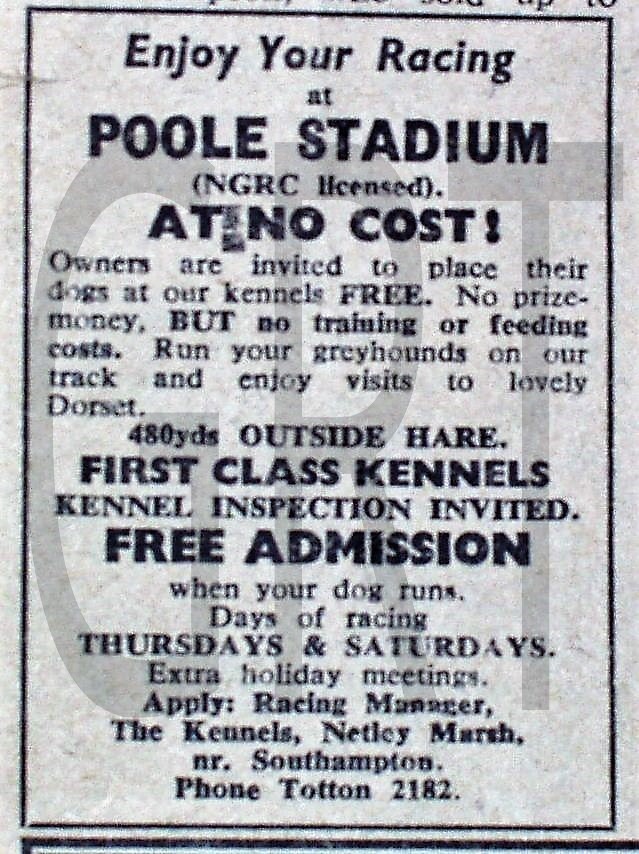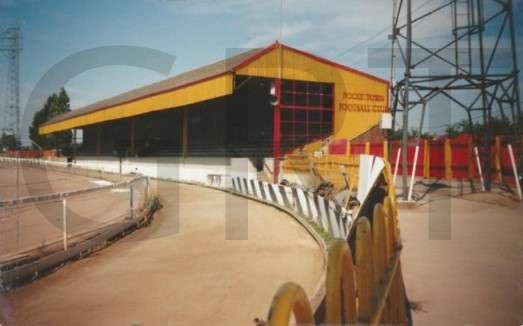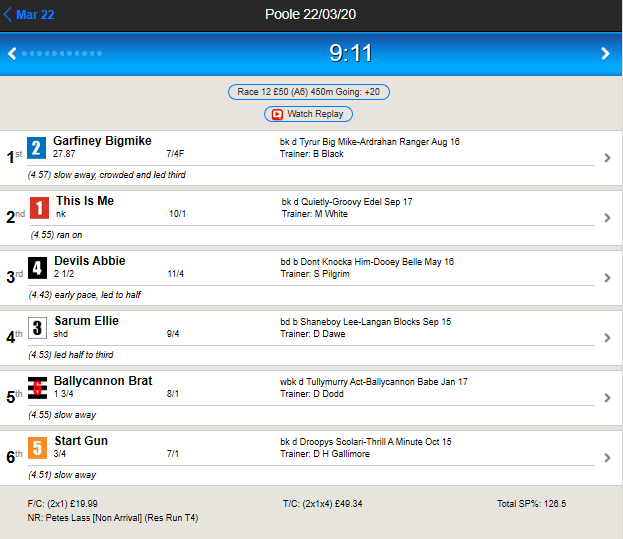Stadium Way, Wimbourne Road, Poole Road, Dorset.
POSTCODE———————————-BH15 2BP
LOCATED————————————About half a mile north of Poole town centre.
ORIGINAL SITE—————————–Grazing land belonging to Heckford Farm and Garden Allotments.
DATE CONSTRUCTED——————–Early 1930’s.
DATE VENUE OPENED——————-August 1933.
Meaning other sports may have taken place prior to the arrival of Greyhound Racing.
FIRST MEETING—————————–May 8th 1961.
Greyhound Racing only.
LICENSED OR INDEPENDENT———-NGRC.
All venues covered would have to be licensed with the government, licensed suggested in this section would refer to tracks operating under NGRC Rules.
INSIDE OR OUTSIDE HARE TYPE——Outside Sumner.
Please note that the Electric Hare suggested is only a guidance and would have been in operation for a certain amount of time at this venue. Although it is not necessarily guaranteed that it was operational all the time, as other types of lure may have been used and updated as time progressed.
DISTANCES———————————–250, 450, 640 and 840 metres.
Please note that most racing venues distances had become varied throughout the years, the ones given above were at once point set and offers only a guidance to the track size.
CIRCUMFERENCE—————————Don’t know.
Please note that alterations at most racing venues throughout its existence would see that the circumference of the track would vary, the one shown above offers only a guidance to the track size.
BIG RACE NAMES—————————The Golden Crescent, The Wessex Vase and The Dorset Classic.
STADIUM SHARED WITH——————Poole Town Football Club and Speedway.
LAST MEETING——————————-Sunday March 22nd 2020.
Greyhound Racing only.
STADIUM CLOSURE DATE—————-Presently closed due to the Covid 19 outbreak.
Meaning other sports may have taken place after Greyhound Racing had ceased.
STADIUM DEMOLITION——————-Venue still lthere
BUILT ON SITE——————————-N/A
In some cases, structure’s that originally covered the venue after the stadium had been demolished, may have been themselves demolished too, so the one described is more likely to be the one which now presently covers the site.
EVIDENCE LEFT TODAY——————-N/A
FURTHER COMMENTS——————–None












When it comes to a location of a greyhound track being an outpost, then Poole Greyhound Stadium must be the one to fit the bill. Although it is Dorset’s one and only greyhound track, when it comes to competition it seems to have more breathing space around it than any other track across the England. Its nearest track is Swindon, which lies almost sixty miles to the north of Poole, and Brighton which lies 80 miles eastward, with nothing at all on its western side.
Poole Greyhound Stadium lies within half a mile of Poole’s town centre, and developed during the early 1930’s on land belonging to Heckford Farm and adjacent garden allotments. Its main reason was to host amateur football, with Poole Town making it their home, opening up with its first competitive match on the 26th of August 1933. It became a venue that would host its matches for the next sixty years or so, with their only absenteeism being the duration of the Second World War, when the site acted as an army base. Once hostilities had ceased Poole Town returned, but it would take another sport that would make use of the venue more than any other in the stadiums history, with the arrival of speedway in 1948. But it was during 1960 that the stadium began to take its present day shape, after £80,000 had been spent on constructing two new grandstands, and also seeing the installation of greyhound racing facilities.
Poole’s first meeting came on the 8th of May 1961, when a greyhound called Count On Chippelgaun won the first ever event. These early years had seen Poole stage five dog races over distances of 480 yards, with the greyhounds chasing an Outside Sumner type hare. The main feature of the stadium was the 1400 seated grandstand, which was officially opened in August 1961 by the FA chairman at the time, Sir Stanley Rous. Further improvements came in 1962, when four football league type floodlight pylons were erected, a change which would instantly become a landmark on the town’s horizon. The football clubs record attendance of 11,155 was set in November 1962 during an FA cup tie against Watford. These early 1960’s years were proving a successful time for Poole Town Football Club, even unsuccessful attempts were made to enter the Football League in 1962 and 1964.
In 1972 efforts were made to attract more greyhounds, a new idea offering owners and trainers to kennel their dogs at the track for no charge at all, even the charge of feeding and training was wavered, but the catch was that there would be no prize money on offer. Improvements of the running surface came during the 1980’s, seeing the track widened to cope with six greyhounds instead of the regular five, and also seeing the installation of a new Swaffham type hare.
The 1980’s became dark years for the venue, witnessing the closure of both greyhound racing and speedway in 1984, due to the sports promoters finding themselves in financial trouble. In January 1985 the promoters went into liquidation, owing over £200,000 in rent to the stadiums owners, Poole Council. They also owed the NGRC £2,000 in unpaid license fees, and trainers became short changed of nearly £10,000 in prize money. Other companies were owed money such as the Electricity Board, who were forced to cut all power feeding the stadium. But power was soon re-connected for the benefit of the football club, as they operated on a separate lease.
Even the late 1980’s proved a turbulent time for greyhound racing, seeing the sport opening and closing a number of times due to changes of management. But success of Poole Town contributed to the end of greyhound racing in 1990, due to the football pitch being widened to meet the league’s criteria, which meant the instant removal of the greyhound track. But success on the football pitch became short lived, seeing the football club fold in 1994, and the reintroduction of greyhound racing. In 1997 improvements were made to the main stand, with the glass fronted restaurant extended to accommodate 312 diners. Along with Peterborough and Sittingbourne, Poole became pioneers of the evening BAGS set up that was experimented in 2011.
The Poole stadium had become a respectable venue to host greyhound racing and speedway, with a 2,500 crowd limit set for greyhounds, although an 8,000 limit had been set when staging speedway meetings. Its big race events had been The Golden Crescent, The Wessex Vase and The Dorset Classic. Race distances were staged over 250, 450, 640 and 840 metres, with six greyhounds chasing the regular outside Swaffham type hare.
Sadly, the Lockdown Rules set by the government regarding the Covid 19 outbreak, had seen what was thought a temporary closure during March 2020. But worse was to follow as the temporary closure had become permanent, with the Sunday meeting on the 22nd of March being its final one. At the time of updating this paragraph, the venue remains dormant, and that is how it will stay until the government relax’s restrictions.

Recent Comments